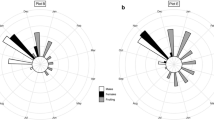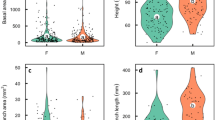Abstract
Sex allocation of a cosexual wind-pollinated species, Quercus dentata (Fagaceae), was analyzed using biomass, carbon, nitrogen and phosphorus as currencies based on data accumulated for 61 individuals from 1997–2004. Strongly female-biased sex allocation was indicated when measured in terms of biomass and carbon, but no significant bias was detected when measured in terms of nitrogen or phosphorus. From an adaptive viewpoint, there is little support for strong female-biased sex allocation, suggesting that sex allocation in terms of nitrogen or phosphorus is closer to the real picture. The relative sex allocation considerably varied from year to year, but the relative femaleness of individuals in the population was rather constant across years. No significant correlation was observed between relative sex allocation and fecundity or tree height, but individuals that showed very low fecundity tended to produce only acorns.

Similar content being viewed by others
References
Aizen MA, Kenigsten A (1990) Floral sex ratios in scrub oak (Quercus ilicifolia) vary with microtopography and stem height. Can J Bot 68:1364–1368
Ashman TL (1994) A dynamic perspective on the physiological cost of reproduction in plants. Am Nat 144:300–316
Ashman TL, Baker I (1992) Variation in floral sex allocation with time of season and currency. Ecology 73:1237–1243
Bloom AJ, Chapin FS III, Mooney HA (1985) Resource limitation in plants—an economic analogy. Annu Rev Ecol Syst 16:363–392
Burd M, Allen TFH (1988) Sexual allocation strategy in wind-pollinated plants. Evolution 42:403–407
Chapin FS III (1989) The cost of tundra plant structures—evaluation of concepts and currencies. Am Nat 133:1–19
Charlesworth D, Charlesworth B (1981) Allocation of resources to male and female functions in hermaphrodites. Biol J Linnean Soc 15:57–74
Charnov EL (1982) The theory of sex allocation. Princeton University, Princeton
Charnov EL (1987) On sex allocation and selfing in higher plants. Evol Ecol 1:30–36
Dow BD, Ashley MV (1996) Microsatellite analysis of seed dispersal and parentage of sapling in bur oak, Quercus macrocarpa. Mol Ecol 5:615–627
Field C, Mooney HA (1986) The photosynthesis–nitrogen relationship in wild plants. In: Givnish T (ed) On the economy of plant form and function. Cambridge University Press, Cambridge, pp 25–55
Freeman DC, McArthur ED, Harper KT, Blauer AC (1981) Influence of environment on the floral sex ratio of monoecious plants. Evolution 35:194–197
Goldman DA, Willson MF (1986) Sex allocation in functionally hermaphroditic plants—a review and critique. Bot Rev 52:157–194
Hashizume H, Suo Z, Lee JH, Yamamoto F (1994) Fundamental studies on the breeding of Quercus species (I) flowering, pollination and seed bearing by artificial pollination (in Japanese). Monogr Coll Japan For Soc 105:321–324
Ishida TA, Hattori K, Sato H, Kimura MT (2003) Differentiation and hybridization between Quercus crispula and Q. dentata (Fagaceae): insights from morphological traits, amplified fragment length polymorphism markers, and leafminer composition. Am J Bot 90:769–776
de Jong TJ, Klinkhamer PGL (1994) Plant size and reproductive success through female and male function. J Ecol 82:399–402
Klinkhamer PGL, de Jong TJ, Metz H (1997) Sex and size in cosexual plants. Trends Ecol Evol 12:260–265
Koelewijn HP, Hunscheid MPH (2000) Intraspecific variation in sex allocation in hermaphroditic Plantago coronopus (L.). J Evol Biol 13:302–315
Lloyd DG (1984) Gender allocations in outcrossing cosexual plants. In: Dirzo R, Sarukhan J (eds) Plant population ecology. Sinauer, Sunderland, pp 227–300
Lloyd DG, Bawa KS (1984) Modification of the gender of seed plants in varying conditions. Evol Biol 17:255–338
McKone MJ, Lund CP, O’Brien JM (1998) Reproductive biology of two dominant prairie grasses (Andropogon gerardii and Sorghastrum nutans, Poaceae): male-biased sex allocation in wind-pollinated plants? Am J Bot 85:776–783
Méndez M, Traveset A (2003) Sexual allocation in single-flowered hermaphroditic individuals in relation to plant and flower size. Oecologia 137:69–75
Miyaki M, Kikuzawa K (1988) Dispersal of Quercus mongolia acorns in a broadleaved deciduous forest 2. Scatterhoarding by mice. For Ecol Manag 25:9–16
Murakami M, Maki M (1994) Sex allocation ratio in a wind-pollinated self-incompatible monoecious tree Alnus firma Sieb. et Zucc. (Betulaceae). Plant Species Biol 7:97–101
Petit RJ, Kremer A, Wagner DB (1993) Geographic structure of chloroplast DNA polymorphisms in European oaks. Theor Appl Genet 87:122–128
R Development Core Team (2004) R: A language and environment for statistical computing. R Foundation for Statistical Computing, Vienna, http://www.R-project.org
Shibata S, Ishida TA, Soeya F, Morino N, Yoshida K, Sato H, Kimura MT (2001) Within-tree variation in density and survival of leafminers on oak Quercus dentata. Ecol Res 16:135–143
Smith SE, Read DJ (1997) Mycorrhizal symbiosis, 2nd edn. Academic Press, San Diego, CA
Sork VL (1984) Examination of seed dispersal and survival in red oak, Quercus rubra (Fagaceae), using metal-tagged acorns. Ecology 65:1020–1022
Streiff R, Ducousso A, Lexer C, Steinkellner H, Gloessl J, Kremer A (1999) Pollen dispersal inferred from paternity analysis in a mixed oak stand of Quercus robur L. and Q. petraea (Matt.) Liebl. Mol Ecol 8:831–841
Yacine A, Bouras F (1997) Self- and cross-pollination effects on pollen tube growth and seed set in holm oak Quercus ilex L. Ann Sci For 54:447–462
Zanetto A, Roussel G, Kremer A (1994) Geographical variation of inter-specific differentiation between Quercus robur L. and Quercus petraea (Matt.) Liebl. For Genet 1:111–123
Acknowledgments
We thank H. Sato, F. Soeya, N. Morino, Y. Kaya, K. Miki, and T. Nakamura for their assistance in the field work, and Prof. T. Kohyama, Prof. T. Hogetsu, and Dr. K. Nara who allowed and helped us to use facilities for final analyses. This work was partly supported by a Grant-in-Aid from the Ministry of Education, Science, Sports and Culture of Japan (No. 15207008).
Author information
Authors and Affiliations
Corresponding author
Rights and permissions
About this article
Cite this article
Ishida, T.A., Hattori, K., Shibata, S. et al. Sex allocation of a cosexual wind-pollinated tree, Quercus dentata, in terms of four currencies. J Plant Res 118, 193–197 (2005). https://doi.org/10.1007/s10265-005-0206-6
Received:
Accepted:
Published:
Issue Date:
DOI: https://doi.org/10.1007/s10265-005-0206-6




